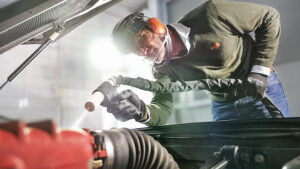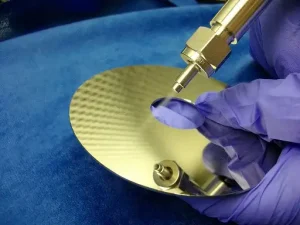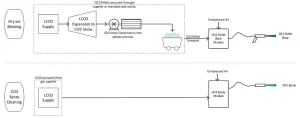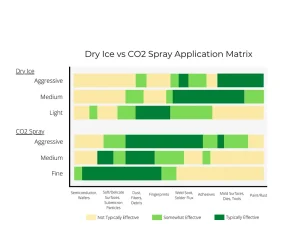by Nelson W. Sorbo, Ph.D., and Parker Nickolay, Cool Clean Technologies, LLC
CO2-based spray technologies have been successfully used for many years to remove problem contamination for a wide range of surfaces, from submicron particles on semiconductor wafers and electronic components to tough residues on injection molds. CO2 spray technologies are an effective, innovative and environmentally friendly cleaning technology option that can be configured in two ways: dry ice blasting and CO2 spray cleaning. Each uses CO2 in a spray jet that is directed at the area to be cleaned. Follow along to see the key differences and similarities between these two cleaning options and how they can be used effectively in various cleaning applications.
What is dry ice blasting?
Dry ice or CO2 pellet blasting is like sand blast or media blast cleaners except the cleaning media is solid CO2. While the CO2 pellet blast spray is much softer than sand or media blast systems, it excels by leaving behind no cleaning media, as the dry ice sublimes upon contact with cleaning surface.
The adjacent figure shows dry ice in pellet form, which has a temperature of -109° F / -78.5° C. Dry ice pellets or blocks are formed by compression of CO2 snow into its desired size and shape. The dry ice blasting system works by entraining dry ice pellets in an air jet through a nozzle directed at the location to be cleaned. As the pellet strikes the surface contamination, the dry ice undergoes a phase transformation in two possible ways: solid-to-gas (sublimination) or solid-to-liquid-to-gas. The impact of solid CO2 with the surface creates four different cleaning mechanisms:
- Momentum exchange – high speed dry ice pellets impact the contaminated surface generate a shear force, which removes the contamination quickly from the surface.
- Thermal shock – the cold dry ice pellets rapidly cool the contaminant and the surface – generating thermal stresses in the residue layer, which facilitates effective removal.
- Chemical – at the dry ice pellet/surface interface, liquid CO2 is instantaneously formed to provide cleaning chemistry useful for removing thin organic films and other hydrocarbon residues.
- Micro-explosion – As the dry ice sublimates, there is a rapid expansion of solid-to-gas, which generates a volumetric expansion of about 700x, essentially exploding the contaminant off the surface.
Combinations of these four mechanisms along with pellet size, jet velocity, nozzle shape and actuation combine to provide an effective cleaning technique, while leaving behind no residue or cleaning media.
Dry ice blasters are an effective solution for numerous industries, including:
- Plastics/foam – injection molds, extrusion dies, tool cleaning, deburring and deflashing
- Medical devices and implants – Silicone molds, catheter, stents, surgical instruments, PEEK and other plastics
- Aviation industry – turbines, engine parts, composites, landing gear, seat assembly, tools
- Electronics and energy – control cabinets, circuit boards, soldering units, electric motors, transformers
- Automotive – engine compartment, plastic trim, undercarriage, rims, brakes, transmission, upholstery
While an effective cleaning option, the drawbacks of dry ice blasting technology are a) the possibility of damaging sensitive surfaces or components on the surface, commonly seen from thermal shock to the surface, and b) the generation of moisture condensation on the part that may negatively impact components.
What is CO2 spray cleaning?
 CO2 spray cleaning, also referred to as CO2 snow cleaning, is like dry ice blasting in that solid CO2 particles are accelerated out of a nozzle with a propellant gas – typically air – at the surface to be cleaned. Other than that, this technology features many differences. In its simplest form, CO2 spray cleaning is liquid CO2 being converted to a mixture of solid and gaseous CO2 particles before being directed to the surface using a spray nozzle. The same four cleaning mechanisms presented above are applicable for CO2 spray cleaning systems, though the effect of thermal shock is typically negligible in most spray cleaning applications. One difference is the effective density of a dry ice pellet is greater than that of the CO2 snow particle.
CO2 spray cleaning, also referred to as CO2 snow cleaning, is like dry ice blasting in that solid CO2 particles are accelerated out of a nozzle with a propellant gas – typically air – at the surface to be cleaned. Other than that, this technology features many differences. In its simplest form, CO2 spray cleaning is liquid CO2 being converted to a mixture of solid and gaseous CO2 particles before being directed to the surface using a spray nozzle. The same four cleaning mechanisms presented above are applicable for CO2 spray cleaning systems, though the effect of thermal shock is typically negligible in most spray cleaning applications. One difference is the effective density of a dry ice pellet is greater than that of the CO2 snow particle.
But unlike dry ice blasting, CO2 spray cleaning combines CO2 snow particles – generated in situ within the system – with a gaseous propellant which makes up the CO2 spray jet. Other options include heating of the propellant and providing an additive that can alter the chemistry of the CO2 snow particle. This combination allows CO2 spray cleaning to generate various surface energy for numerous applications to remove particles, thin organic films, fingerprints and many other residues for optics, electronics, automotive, semiconductor, medical device and aerospace cleaning applications. Unlike the aggressive dry ice blasting process, CO2 spray cleaning encounters limitations typically involving challenging residues, such as tough adhesives, some injection mold residues, rust, and paint which require more abrasive methods to remove.
Comparing dry ice blasting and CO2 sprays
While both used cleaning jets incorporating solid CO2 particles, there are substantial differences in how these sprays are generated and how they can be used.
How CO2 particles are generated
The principal difference between cleaning with dry ice particles and cleaning with CO2 spray/snow particles is the way in which they are formed. As noted above, dry ice pellets are generated by compressing CO2 into the desired size/shape compatible with the dry ice blaster. Pellets are frequently procured from an external supplier. As seen in Figure 1, after the pellets are generated, they are conveyed to the pellet blaster for use. Whereas the CO2 particles used in CO2 spray systems are generated by condensation of liquid CO2 to CO2 snow inside the spray nozzle assembly, creating a simpler way to produce the effective spray.
Another comparison to the cleaning performance between the two technologies, involves the purity of CO2. For critical cleaning applications with stringent cleaning requirements, dry ice blasters are not well suited as it is exceedingly difficult to obtain CO2 pellets made with high purity CO2. Alternatively, high quality CO2 can be easily procured from suppliers or purified within the CO2 spray system to meet this demanding specification. As such, CO2 spray systems are typically preferred over dry ice blasting systems for these applications.
Cleaning energy
Because CO2 spray systems typically utilize smaller and “softer” CO2 particles compared with the CO2 pellets used in dry ice blasters, the cleaning energy available from a dry ice blaster is greater than that for typical CO2 spray systems. Hence if an application requires an aggressive level of cleaning energy – say heavy residue or rust removal – the dry ice blasting system will be the preferred choice. However, if the cleaning challenge involves residue removal form substrates that are soft or have delicate components on them, then the CO2 spray system is preferred. And in the “middle” of the cleaning energy spectrum, both technologies can be effective. In these cases, the preferred choice is based on other factors. Figure 2 provides a high-level overview of candidate cleaning system configurations with various residues and applications. CO2 spray systems include the fine, medium and aggressive spray types to correspond with different nozzle options available to adjust the CO2 particle size. The dry ice pellet blast options are partitioned into light, medium and aggressive configurations, which are determined by the pellet or dry ice particle size, compressed air jet velocity and nozzle design. Each residue category / application is evaluated as “typically effective,” “somewhat effective” and “not typically effective.” There are exceptions to this categorization. Examination of the figure shows substantial overlap in the capabilities of either technology option.
Spray temperature
 Solid CO2 is cold: -79° C. Hence when used in a cleaning spray alone or mixed with compressed air, solid CO2 will generate a very cold spray, which easily can cool many parts below the dew point of the cleaning environment, resulting in condensation and a “wet” part. Although for some applications, condensation moisture is not an issue, there are many applications in which generation of moisture from the cleaning spray is not acceptable.
Solid CO2 is cold: -79° C. Hence when used in a cleaning spray alone or mixed with compressed air, solid CO2 will generate a very cold spray, which easily can cool many parts below the dew point of the cleaning environment, resulting in condensation and a “wet” part. Although for some applications, condensation moisture is not an issue, there are many applications in which generation of moisture from the cleaning spray is not acceptable.
Dry ice blasting generates a spray that is cold and will generate surface condensation in most cleaning environments. While the temperature of the dry ice is constant, the effective temperature of the spray can be modified by changing the relative mass rates of CO2 pellets and compressed air. Typically, the dry ice blasting spray will be cold and pull moisture from the cleaning atmosphere. The condensation issues can be managed by rapid movement of the spray nozzle over the surface, heating the part to be cleaned, or by cleaning the part in a “dry box.”
While CO2 spray systems also used the same cold CO2 solid particles, the temperature of the spray is easily mitigated by adjusting the relative quantity of compressed air compared to CO2, by changing the temperature of the compressed air mixed with the CO2 particles and modifying the cleaning nozzle speed or distance to the part. These simple modifications on the CO2 spray temperature can prevent moisture on the parts during the cleaning process.
Spray chemistry
Chemistry in dry ice blasting and CO2 spray systems comes from interaction of the CO2 particle on the surface, which – if the surface impact pressure is sufficient – can generate instant liquid CO2 at the interface. Liquid CO2 has chemical properties that make it an effective solvent for many light oils, fingerprints and other non-polar or mildly polar organics. Therefore, without any additional additives, both these technologies are effective in solubilizing and removing this type of residue.
However, for residues that are more complex, it becomes advantageous to modify the chemistry of the spray. This can be achieved by adding soluble co-solvents to the liquid CO2 to change the cleaning chemistry of the CO2 particle on impact. With these modifications, residues that could not be removed or required extensive time to remove now can be easily removed from the surface. This spray chemistry modification is offered among CO2 spray offerings.
Other factors

There are other factors to consider when comparing these technologies. While dry ice blasters can deliver substantially more cleaning energy surface to be cleaned, they require more CO2 per nozzle than do CO2 spray systems. For example, dry ice blasting systems can use between 5-35 kg/hr of pellet for a single nozzle, compared to CO2 usage rates of 3-8 kg/hr/nozzle for CO2 spray systems. Additionally, the price of CO2 pellets is typically two to four times more expensive per kilogram than CO2 depending on the quality grade required. Compressed air usage for dry ice blasting is larger and the required delivery pressure higher than that necessary for a CO2 spray system. However, many precision CO2 spray system applications require clean dry air (CDA) – ISO Class 1-2 – for effective cleaning, which is much more expensive than typical compressed air. The noise of the spray jets from both systems is an issue which must be managed with the correct PPE with noise levels of 115 dB or higher for dry ice blasting systems. Though CO2 spray systems do not typically generate the same noise level, either hearing protection or employing a spray enclosure to block the noise impacting the operators must be employed. Further, as CO2 is an asphyxiant, accumulations of the gas must monitored by CO2 sensors and be managed by appropriate ventilation for worker safety in both cases.
In summary

Both dry ice blasting systems and CO2 spray systems are highly effective cleaning alternatives for many different industrial, commercial and technical cleaning challenges. They each have their strengths and limitations. Dry ice blasters can be configured to provide an extremely aggressive spray capable of removing many tough residues, though has been shown to cause damage to sensitive substrates. CO2 spray cleaning systems are remarkably effective in removing particulate matter and thin films from surfaces requiring a critical cleaning method, but do not have the cleaning energy to remove tougher residues. The capabilities of both technologies overlap in the “middle” of the cleaning spectrum were either option can be effective. In these cases, the selection of the best alternative should be based on other factors such as cost, ease of use, automation compatibility and other factors.
Dr. Nelson Sorbo is vice president of research and development and Parker Nickolay is the senior marketing coordinator for Cool Clean Technologies, LLC, a CO2-based technology and manufacturing company that supplies both CO2 spray cleaning and dry ice blasting equipment to its customers. Visit www.coolclean.com to learn more.


